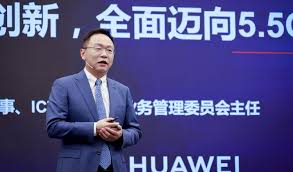2024 marks first year of commercial 5.5G, integration of AI into wider variety of devices: David Wang

Shanghai: David Wang, Huawei’s Executive Director of the Board and Chairman of the ICT Infrastructure Managing Board Thursday announced that 2024 marks the first year of commercial 5.5G and the integration of AI into a wider variety of devices.
During his keynote speech on “Advancing 5.5G and Shaping the Mobile AI Era,” at MWC Shanghai 2024 he said, “The mobile AI era is on the horizon, where intelligent services will be pervasive. We must work hard on both Networks for AI and AI for Networks to accelerate 5.5G development and maximize the value of the mobile AI era.”
Wang highlighted the remarkable success of commercial 5G over the past five years, noting its unprecedented impact on the global mobile industry by extending the breadth of global services, delivering higher speeds for better experiences, and deepening digital transformation worldwide.
He said that 5G continues to develop rapidly, with the first standards release for 5G-Advanced – 3GPP Release-18 – officially frozen on June 28, 2024, in Shanghai. More than 60 carriers and partners have also announced commercial 5.5G deployment.
The evolution of wireless communications technologies has ushered in several significant eras. In 1991, GSM networks and the widespread adoption of mobile phones initiated the mobile voice era.
In 2007, 3G and smartphones led the mobile Internet era, making global information readily accessible. He posits that 2024 marks the beginning of the mobile AI era, where three seismic changes will occur:
He said that interaction will shift from being touch-based to multimodal, extending to natural language, gestures, and emotions, providing on-demand, 24/7 experiences.
He added, that AI will revolutionize content generation, moving from information retrieval to customization, making comprehensive and tailored real-time services available.
Mobile devices will evolve from smartphones to AI terminal assistants and embodied AI, becoming portals to seamless AI, he added.
He said that graphical interaction has driven mobile data traffic growth, outpacing Moore’s Law for the past decade, and expects this trend to continue with new forms of interaction and generative content, increasing interaction efficiency and content volume.
In the field of the Internet of Vehicles (IoV), he highlighted that intelligent connected vehicles would reshape driving, making it safer, easier, and more enjoyable.





